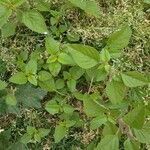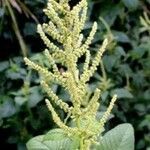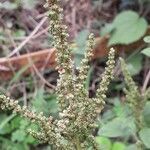Annual, monoecious herb to 1 m; stems bluntly triangular, pink to green, glabrous, or puberulent above. Petiole to 10 cm, not quite as long as blade; blade ovate-rhombic, ovate, ovate-oblong, lanceolate or bluntly triangular, (0.3-)1.5 x 6(-9) cm, apex obtuse to truncate, mucronulate, shallowly emarginate to 1 mm deep, base cuneate to subtruncate, glabrous, sometimes pilose beneath. Inflorescence of axillary clusters and terminal spikes or panicles 1-8(-20) cm long; bracts and bracteoles hyaline, ovate, 0.5-1.0 mm long, awned, much shorter than to subequalling perianth. Flowers white-membranous with green midvein. Male flowers few, near tips of terminal inflorescences; tepals 3, subequal, elliptical, oblong or ovate, 1.0-1.5 mm long, concave, acute; stamens 2-3. Female flowers more numerous than male, in axillary clusters and throughout terminal inflorescence; tepals 3, oblong, obovate or oblanceolate, 1.2-1.75 mm long, acute, equalling utricle; ovary oblong, styles 2-3. Utricle indehiscent, globose or suborbicular, 1.25-1.50 mm long, exceeding perianth, yellowish-brown, prominently rugulose throughout; seed orbicular, lenticular, 0.9-1.2 mm long, dark reddish-brown to black, shining.
Plants annual, sometimes short-lived perennial in tropics and subtropics, glabrous. Stems erect, simple or with lateral branches (especially distally), 0.2-1 m. Leaves: petiole 1/2-11/2 as long as blade; blade rhombic-ovate or ovate, 1-7 × 0.5-5 cm, base rounded, cuneate, or attenuate, margins entire, plane, apex obtuse, rounded, or emarginate, mucronate. Inflorescences slender spikes aggregated into elongate terminal panicles, also from distal axils, green, leafless at least distally. Bracts of pistillate flowers ovate to lanceolate, 1 mm, shorter than tepals. Pistillate flowers: tepals 3, narrowly elliptic, obovate-elliptic or spatulate, not clawed, ± equal, 1.2-1.7 mm, apex rounded or nearly acute, mucronate or not; style branches erect; stigmas 3. Staminate flowers inconspicuous, mostly at tips of inflorescences; tepals 3; stamens 3. Utricles ovoid to compressed-ovoid, 1-1.6 mm, equaling or slightly exceeding tepals, prominently or faintly rugose, indehiscent. Seeds black or dark brown, subglobose to thick-lenticular, 1 mm diam., minutely punctulate, rather dull.
Rather delicate glabrous annuals to as much as I m. high, the branches ascend-ing. Leaves glabrous, entire to minutely crenulate, deltoid-to rhombic-ovate, apically emarginate to rounded and mucronate, basally truncate to subacute, 1.5-6 cm. long, 1-4 cm. broad, the petioles 0.5-4 cm. long. Inflorescences of thyrses racemosely disposed, the terminal and axillary thyrses cylindric, mostly less than 7 mm. broad. Flowers polygamo-monoecious or monoecious; bracts 'and bracteoles subequal, lanceolate to ovate, ca. 1 mm. long; sepals 3, linear-oblong to pbovate, rounded, mucronate, 1-1.5 mm. long, the midrib dark green, the margins scariose; stamens 3, discrete, 1-1.5 mm. long; ovary compressed-globose; style 1, minute, stigmata 3, longer than the style. Fruit an indehiscent, strongly rugose utricle, 1-1.5 mm. long, 1-1.5 broad; seeds cochleate-orbiculate, dark red to black, dull, minutely pebbled, 1-1.2 mm. broad.
Sprawling or suberect annual herb, to c. 40 cm high, sparingly hairy except for young stems. Petioles of lvs of non-flowering shoots and lower part of flowering shoots to c. 6 cm long, those of infl.-lvs often much shorter. Lamina 1.7-6.5 × 8-5.5 cm, ovate or triangular-ovate, becoming glabrous above, usually remaining puberulent on the prominent pale nerves below, undulate or ± crenulate; base cuneate; apex obtuse to emarginate. Infl. a dense, elongated, terminal, puberulent spike, and branches below, usually also with short axillary spikes in upper lf axils, usually greenish brown or brown. Bracteoles 0.8-1.3 mm long, broadly ovate, mucronate, with green keel. Tepals 3, 1-1.4 mm long, oblong-spathulate, > bracteoles; keel green, ± mucronate. Fr. subglobose, = or slightly > perianth, prominently rugose, indehiscent. Seed 0.9-1.1 mm diam., subglobose, black or dark brown, occupying nearly all fr. cavity.
Stem erect, green or somewhat tinged purple, 40-80 cm tall, conspicuously angulate, slightly branched, glabrous. Petiole 3-6 cm, green or somewhat tinged purple; leaf blade ovate, ovate-oblong, or ovate-elliptic, 3-9 × 2.5-6 cm, base broadly cuneate or subtruncate, margin entire or slightly undulate, apex notched or rounded, with a pointed mucro. Complex thyrsoid structures terminal, 6-12 × 1.5-3 cm, branched, composed of spikes; spikes erect, slender, terminal ones longer than lateral ones; rachis 2-2.5 cm. Bracts and bracteoles lanceolate, shorter than 1 mm, apex pointed. Tepals oblong or broadly oblanceolate, 1.2-1.5 mm, apex acute. Stamens shorter than perianth; stigmas 3 or 2. Utricles green, longer than perianth, globose, slightly compressed, ca. 2 mm in diam., very rugose, indehiscent. Seeds black or brownish black, subglobose, ca. 1 mm in diam. Fl. Jun-Aug, fr. Aug-Oct. 2n = 34.
A herb 10-75 cm high. The stems are branched and angular and without hairs. The leaves are alternate and not quite rectangular in shape. The leaves are 3-9 cm long by 2-6.5 cm wide. The leaf stalk is 2.5-6.5 cm long. The flowers occur in a clustered flower head. These occur in the axils of leaves. The flower heads form a spike at the end of the branches. This spike is 2.5-12 cm long. The flowers are green with male and female flowers together. The fruit is a small almost round capsule. It is 1.2-1.5 mm across. The seed are shiny black and 1 mm across.
Monoecious; erect, to 1 m; lvs broadly ovate or rhombic-ovate, 3–7 cm, often retuse, acute or rounded at base; thyrses few or several, the lateral ascending, not much shorter than the terminal, forming a panicle 1–2 dm; bracts much shorter than the fls; sep of the pistillate fls 3, oblanceolate, shorter than the fr, acute; fr compressed-obovoid, 1.5 mm, very rugose when dry, indehiscent; seed orbicular, sharp-edged, 1 mm; 2n=34. Probably native to tropical Amer., now a pantropic weed and occasionally adventive in our range.
Perennial herb, short-lived, main stems decumbent, up to 1 m long, with many branches, pubescent when young. Leaves green without blotches; lamina mostly ovate, glabrous or inconspicuous pubescence on midrib, base attenuate, apex rounded; axils without spines; petioles 20-60(-80) mm long. Inflorescences green, branched, terminal panicles; male flowers few, mixed with female flowers. Flowering time Dec.-Apr. Seed only slightly shining, blackish.
Leaves glabrous or shortly to fairly long-pilose on the lower surface of the primary or most of the venation, long-petiolate (petioles up to c. 10 cm. long and the longest commonly longer than the lamina), lamina deltoid-ovate to rhomboid-oblong, 2–7 × 1.5–5.5 cm., the margins occasionally obviously sinuate, shortly cuneate to subtruncate below, obtuse and narrowly to clearly emarginate at the apex, minutely mucronate.
Perianth segments 3, very rarely 4, those of the male flowers oblong-elliptic, acute, concave, c. 1.5 mm. long, shortly mucronate; those of the female flowers narrowly oblong to narrowly spathulate, finally 1.25–1.75 mm. long, the borders white-membranous, minutely mucronate or not, midrib green and often thickened above.
Flowers green, in slender, axillary or terminal, frequently paniculate spikes c. 2.5–12 cm. long and 2–5 mm. wide, or in the lower part of the stem in dense axillary clusters to c. 7 mm. in diam.; male and female flowers intermixed but the latter more numerous.
Stem rather slender, sparingly to considerably branched, angular, glabrous or more frequently increasingly (but still rather sparsely) hairy upwards (especially in the inflorescence) with short or longer and rather floccose multicellular hairs.
Bracts and bracteoles deltoid-ovate to lanceolate-ovate, whitish-membranous with a very short pale or reddish awn formed by the excurrent green midrib, bracteoles shorter than the perianth (c. 1 mm. long).
Short-lived perennial herb, up to 1 m high. Inflorescence a terminal branched or spike-like panicle. Fruits indehiscent, closely and regularly wrinkled, not or slightly exceeding perianth. Flowers green.
Seed c. 1–1.25 mm. in diam., circular, only slightly compressed, more or less shining, reticulate and with shallow the verrucae on reticulum, the verrucae with shape of the areolae.
Capsule subglobose, 1.25–1.75 mm. in diam., not or only slightly exceeding the perianth, indehiscent or rupturing irregularly, very strongly rugose throughout at maturity.
Short-lived perennial herb (sometimes flowering in first year), erect or more rarely ascending, 10–75 (100) cm.
Stigmas 2–3, short, erect or almost so.












